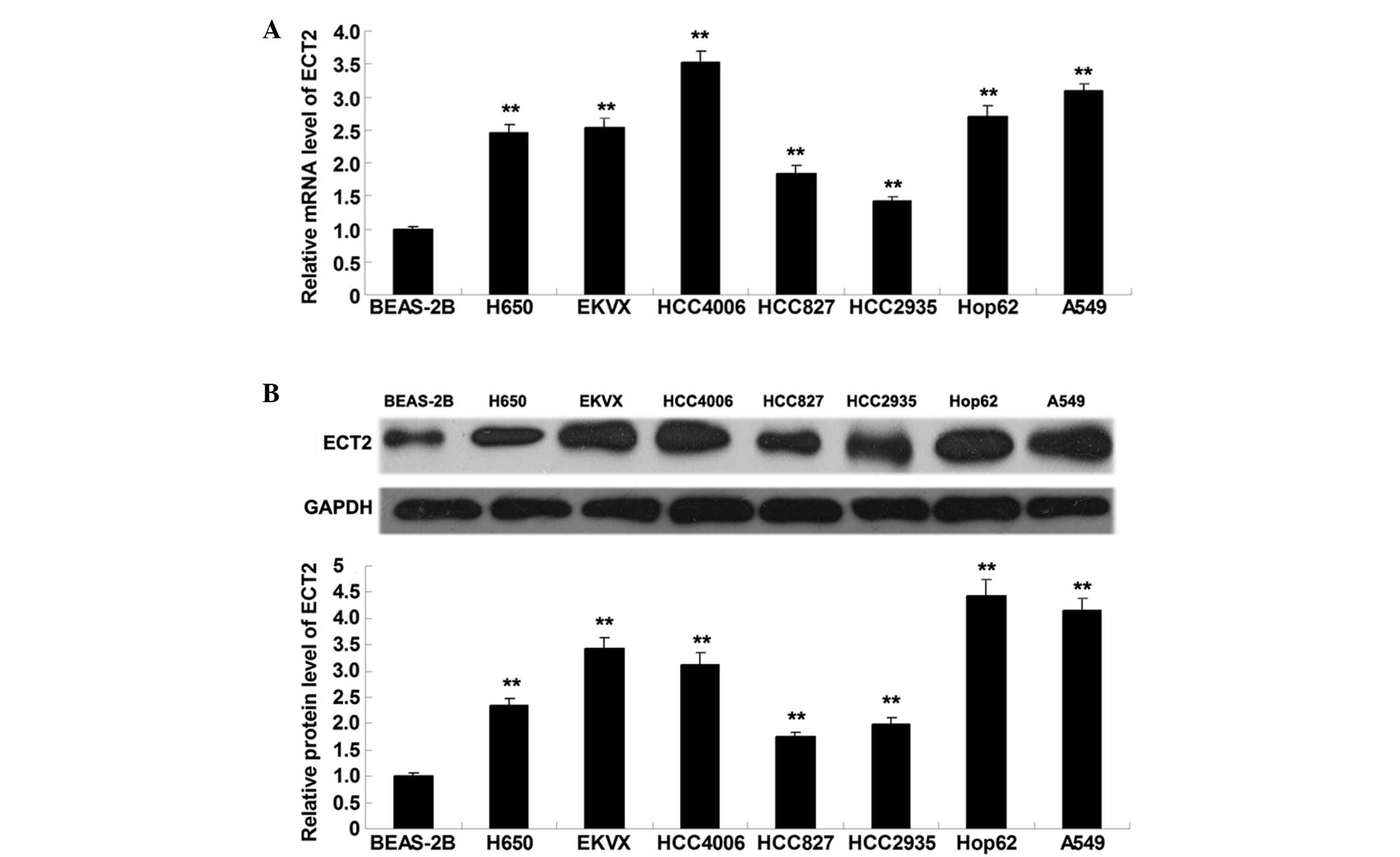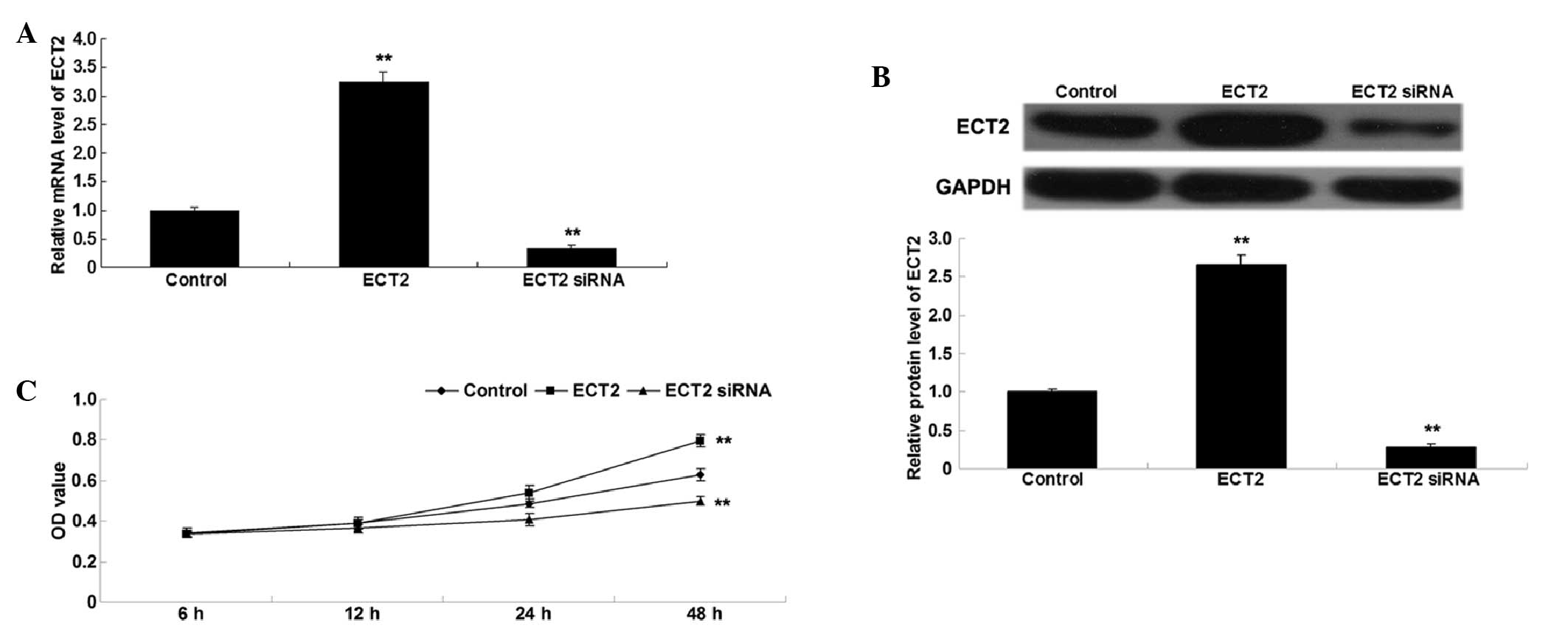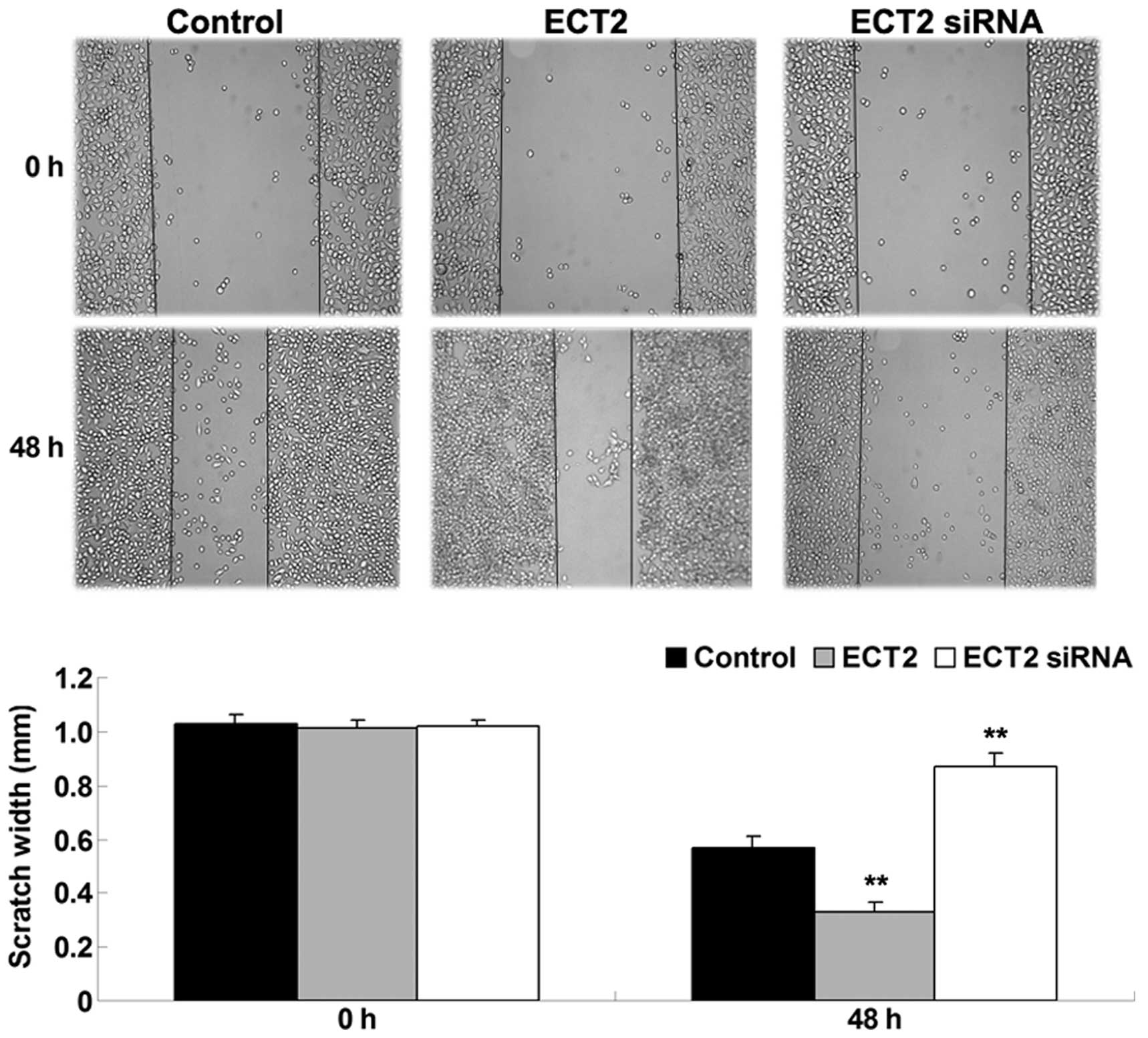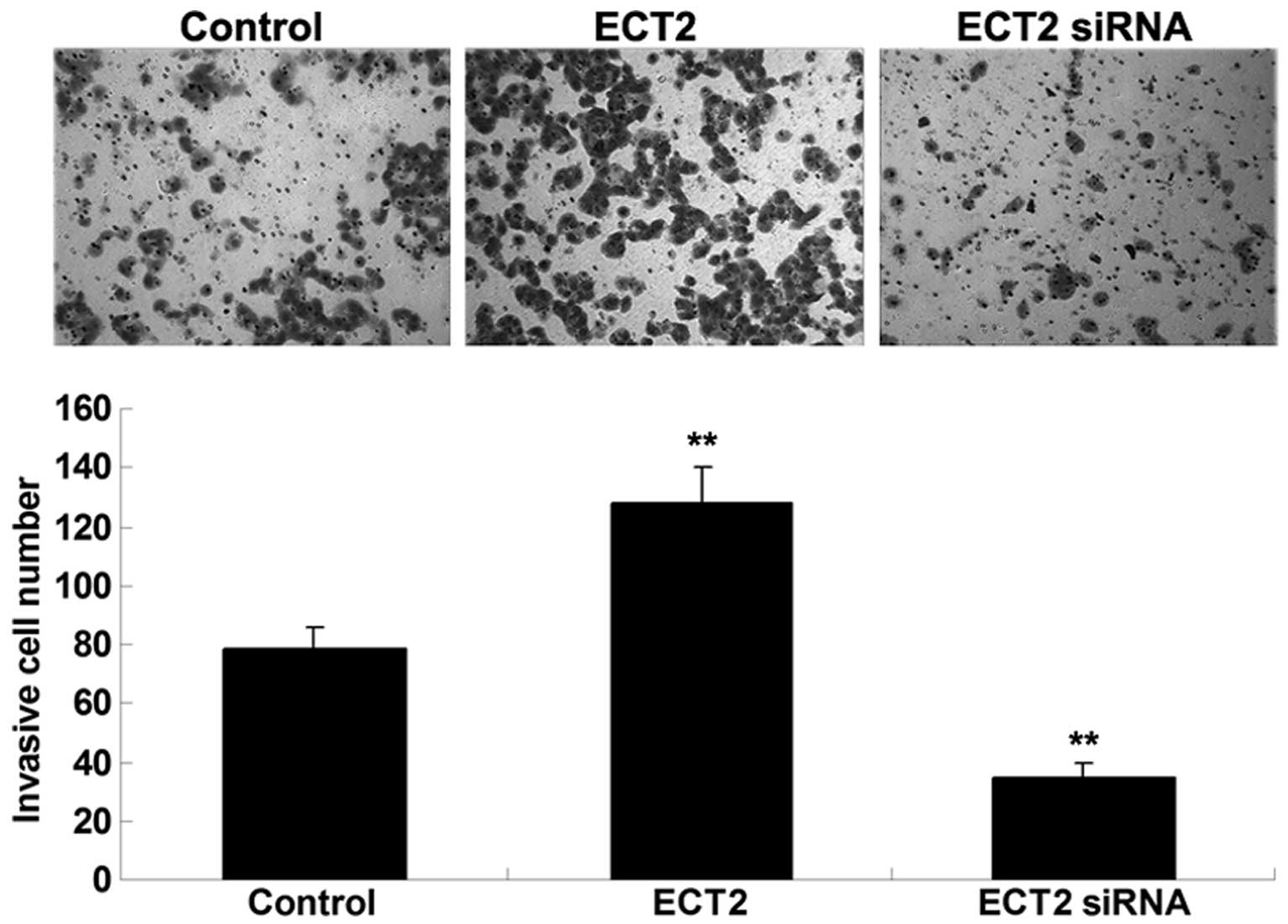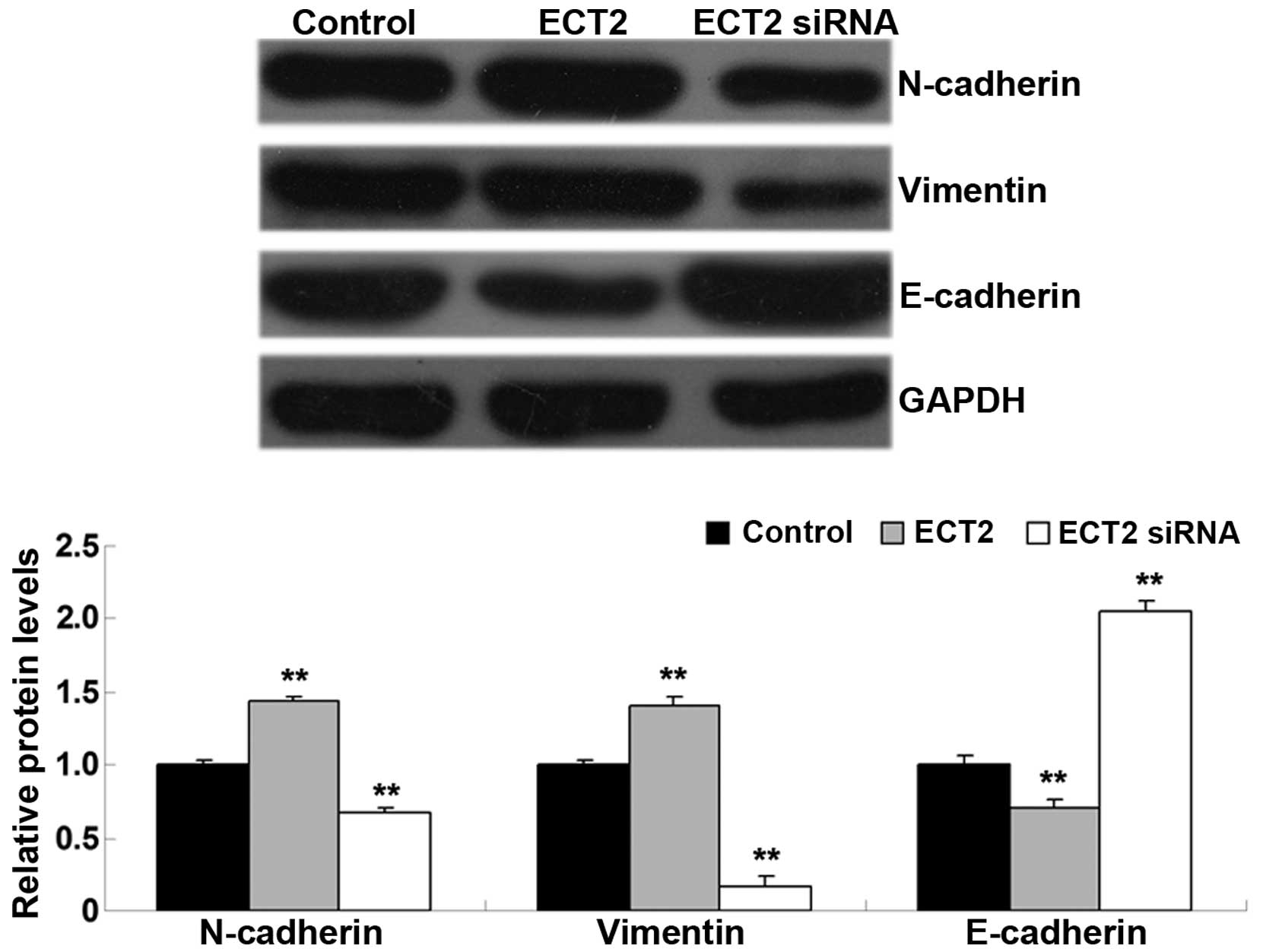|
1
|
Siegel RL, Miller KD and Jemal A: Cancer
statistics, 2015. CA Cancer J Clin. 65:5–29. 2015. View Article : Google Scholar : PubMed/NCBI
|
|
2
|
Liang W, Gao B, Fu P, Xu S, Qian Y and Fu
Q: The miRNAs in the pathgenesis of osteosarcoma. Front Biosci
(Landmark Ed). 18:788–794. 2013. View
Article : Google Scholar : PubMed/NCBI
|
|
3
|
Siegel R, Naishadham D and Jemal A: Cancer
statistics, 2013. CA Cancer J Clin. 63:11–30. 2013. View Article : Google Scholar : PubMed/NCBI
|
|
4
|
Tatsumoto T, Xie X, Blumenthal R, Okamoto
I and Miki T: Human ECT2 is an exchange factor for Rho GTPases,
phosphorylated in G2/M phases and involved in cytokinesis. J Cell
Biol. 147:921–928. 1999. View Article : Google Scholar : PubMed/NCBI
|
|
5
|
Salhia B, Tran NL, Chan A, Wolf A, Nakada
M, Rutka F, Ennis M, McDonough WS, Berens ME, Symons M and Rutka
JT: The guanine nucleotide exchange factors trio, Ect2 and Vav3
mediate the invasive behavior of glioblastoma. Am J Pathol.
173:1828–1838. 2008. View Article : Google Scholar : PubMed/NCBI
|
|
6
|
Jin Y, Yu Y, Shao Q, Ma Y, Zhang R, Yao H
and Xu Y: Up-regulation of ECT2 is associated with poor prognosis
in gastric cancer patients. Int J Clin Exp Pathol. 7:8724–8731.
2014.PubMed/NCBI
|
|
7
|
Sano M, Genkai N, Yajima N, Tsuchiya N,
Homma J, Tanaka R, Miki T and Yamanaka R: Expression level of ECT2
proto-oncogene correlates with prognosis in glioma patients. Oncol
Rep. 16:1093–1098. 2006.PubMed/NCBI
|
|
8
|
Chen J, Xia H, Zhang X, Karthik S, Pratap
SV, Ooi LL, Hong W and Hui KM: ECT2 regulates the Rho/ERK
signalling axis to promote early recurrence in human hepatocellular
carcinoma. J Hepatol. 62:1287–1295. 2015. View Article : Google Scholar : PubMed/NCBI
|
|
9
|
Justilien V, Jameison L, Der CJ, Rossman
KL and Fields AP: Oncogenic activity of Ect2 is regulated through
protein C iota-mediated phosphorylation. J Biol Chem.
286:8149–8157. 2011. View Article : Google Scholar : PubMed/NCBI
|
|
10
|
Murata Y, Minami Y, Iwakawa R, Yokota J,
Usui S, Tsuta K, Shiraishi K, Sakashita S, Satomi K, Iijima T and
Noguchi M: ECT2 amplification and overexpression as a new
prognostic biomarker for early-stage lung adenocarcinoma. Cancer
Sci. 105:490–497. 2014. View Article : Google Scholar : PubMed/NCBI
|
|
11
|
Livak KJ and Schmittgen TD: Analysis of
relative gene expression data using real-time quantitative PCR and
the 2−ΔΔCt method. Methods. 25:402–408. 2001. View Article : Google Scholar : PubMed/NCBI
|
|
12
|
Ahmad A, Maitah MY, Ginnebaugh KR, Li Y,
Bao B, Gadgeel SM and Sarkar FH: Inhibition of Hedgehog signaling
sensitizes NSCLC cells to standard therapies through modulation of
EMT-regulating miRNAs. J Hematol Oncol. 6:772013. View Article : Google Scholar : PubMed/NCBI
|
|
13
|
Yang YL, Chu JY, Luo ML, Wu YP, Zhang Y,
Feng YB, Shi ZZ, Xu X, Han YL, Cai Y, et al: Amplification of
PRKCI, located in 3q26, is associated with lymph node metastasis in
esophageal squamous cell carcinoma. Genes Chromosomes Cancer.
47:127–136. 2008. View Article : Google Scholar : PubMed/NCBI
|
|
14
|
Hussenet T, Dali S, Exinger J, Monga B,
Jost B, Dembelé D, Martinet N, Thibault C, Huelsken J, Brambilla E
and du Manoir S: SOX2 is an oncogene activated by recurrent 3q26.3
amplifications in human lung squamous cell carcinomas. PLoS One.
5:e89602010. View Article : Google Scholar : PubMed/NCBI
|
|
15
|
Wang Y, Hill KS and Fields AP: PKCi
maintains a tumor-initiating cell phenotype that is required for
ovarian tumorigenesis. Mol Cancer Res. 11:1624–1635. 2013.
View Article : Google Scholar : PubMed/NCBI
|
|
16
|
Nalini V, Segu R, Deepa PR, Khetan V,
Vasudevan M and Krishnakumar S: Molecular Insights on
post-chemotherapy retinoblastoma by microarray gene expression
analysis. Bioinform Biol Insights. 7:289–306. 2013. View Article : Google Scholar : PubMed/NCBI
|
|
17
|
Samuel N, Sayad A, Wilson G, Lemire M,
Brown KR, Muthuswamy L, Hudson TJ and Moffat J: Integrated genomic,
transcriptomic and RNA-interference analysis of genes in somatic
copy number gains in pancreatic ductal adenocarcinoma. Pancreas.
42:1016–1026. 2013. View Article : Google Scholar : PubMed/NCBI
|
|
18
|
Vazquez-Mena O, Medina-Martinez I,
Juarez-Torres E, Barrón V, Espinosa A, Villegas-Sepulveda N,
Gómez-Laguna L, Nieto-Martínez K, Orozco L, Roman-Basaure E, et al:
Amplified genes may be overexpressed, unchanged, or downregulated
in cervical cancer cell lines. PLoS One. 7:e326672012. View Article : Google Scholar : PubMed/NCBI
|
|
19
|
Jung Y, Lee S, Choi HS, Kim SN, Lee E,
Shin Y, Seo J, Kim B, Jung Y, Kim WK, et al: Clinical validation of
colorectal cancer biomarkers identified from bioinformatics
analysis of public expression data. Clin Cancer Res. 17:700–709.
2011. View Article : Google Scholar : PubMed/NCBI
|
|
20
|
Iyoda M, Kasamatsu A, Ishigami T,
Nakashima D, Endo-Sakamoto Y, Ogawara K, Shiiba M, Tanzawa H and
Uzawa K: Epithelial cell transforming sequence 2 in human oral
cancer. PLoS One. 5:e140822010. View Article : Google Scholar : PubMed/NCBI
|
|
21
|
Zhang H, Yin Z, Ning K, Wang L, Guo R and
Ji Z: Prognostic value of microRNA-223/epithelial cell transforming
sequence 2 signaling in patients with osteosarcoma. Hum Pathol.
45:1430. 2014. View Article : Google Scholar : PubMed/NCBI
|
|
22
|
Hirata D, Yamabuki T, Miki D, Ito T,
Tsuchiya E, Fujita M, Hosokawa M, Chayama K, Nakamura Y and Daigo
Y: Involvement of epithelial cell transforming sequence-2
oncoantigen in lung and esophageal cancer progression. Clin Cancer
Res. 15:256–266. 2009. View Article : Google Scholar : PubMed/NCBI
|
|
23
|
Saito S, Tatsumoto T, Lorenzi MV, Chedid
M, Kapoor V, Sakata H, Rubin J and Miki T: Rho exchange factor ECT2
is induced by growth factors and regulates cytokinesis through the
N-terminal cell cycle regulator-related domains. J Cell Biochem.
90:819–836. 2003. View Article : Google Scholar : PubMed/NCBI
|
|
24
|
Xu J, Yao Q, Hou Y, Xu M, Liu S, Yang L,
Zhang L and Xu H: miR-223/Ect2/p21 signaling regulates osteosarcoma
cell cycle progression and proliferation. Biomed Pharmacother.
67:381–386. 2013. View Article : Google Scholar : PubMed/NCBI
|
|
25
|
Fortin SP, Ennis MJ, Schumacher CA,
Zylstra-Diegel CR, Williams BO, Ross JT, Winkles JA, Loftus JC,
Symons MH and Tran NL: Cdc42 and the guanine nucleotide exchange
factors Ect2 and trio mediate Fn14-induced migration and invasion
of glioblastoma cells. Mol Cancer Res. 10:958–968. 2012. View Article : Google Scholar : PubMed/NCBI
|
|
26
|
Yu JR, Tai Y, Jin Y, Hammell MC, Wilkinson
JE, Roe JS, Vakoc CR and Van Aelst L: TGF-β/Smad signaling through
DOCK4 facilitates lung adenocarcinoma metastasis. Genes Dev.
29:250–261. 2015. View Article : Google Scholar : PubMed/NCBI
|
|
27
|
McInnes LM, Jacobson N, Redfern A, Dowling
A, Thompson EW and Saunders CM: Clinical implications of
circulating tumor cells of breast cancer patients: Role of
epithelial-mesenchymal plasticity. Front Oncol. 5:422015.
View Article : Google Scholar : PubMed/NCBI
|
|
28
|
Beuran M, Negoi I, Paun S, Ion AD, Bleotu
C, Negoi RI and Hostiuc S: The epithelial to mesenchymal transition
in pancreatic cancer: A systematic review. Pancreatology.
15:217–225. 2015. View Article : Google Scholar : PubMed/NCBI
|



